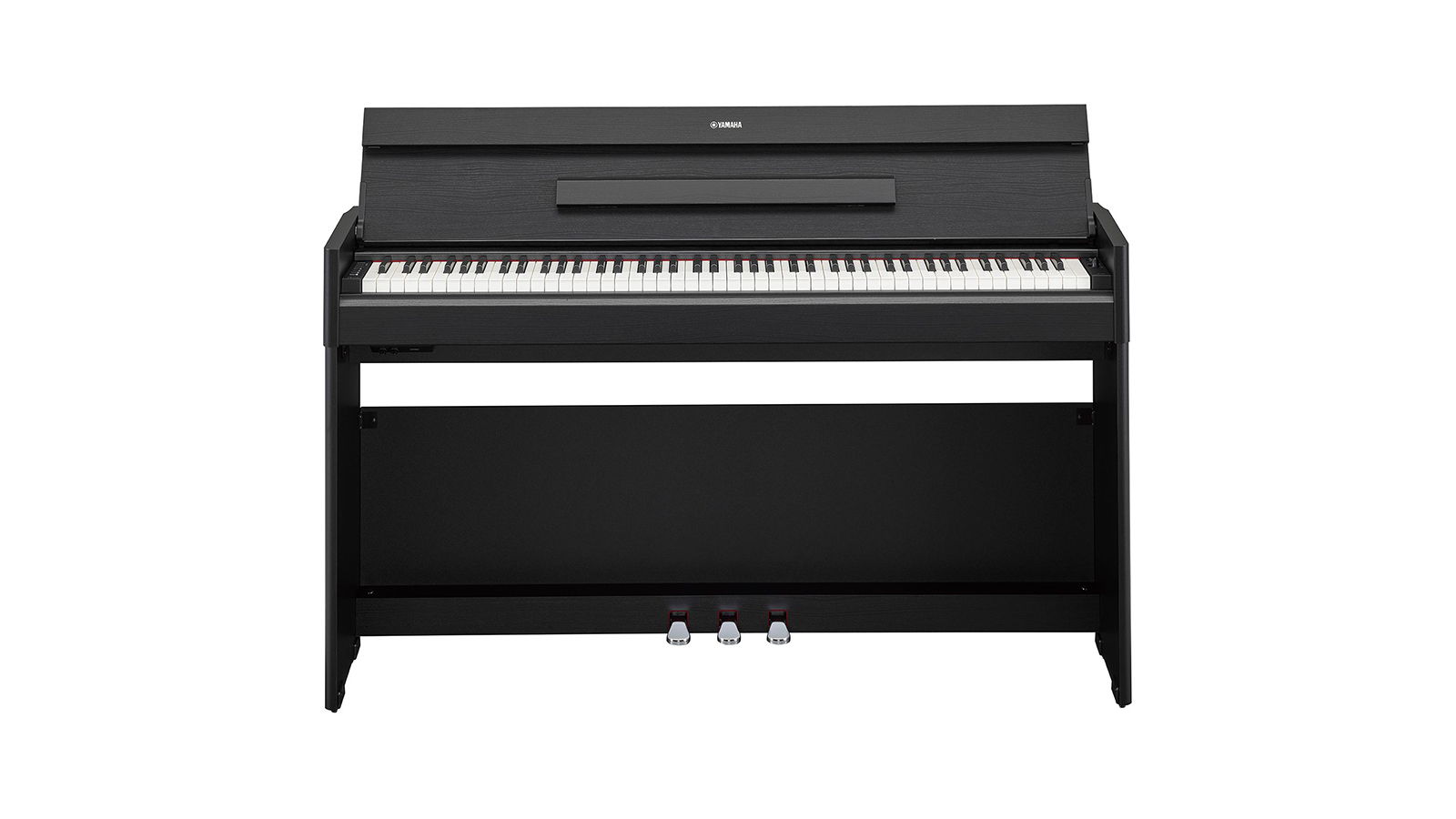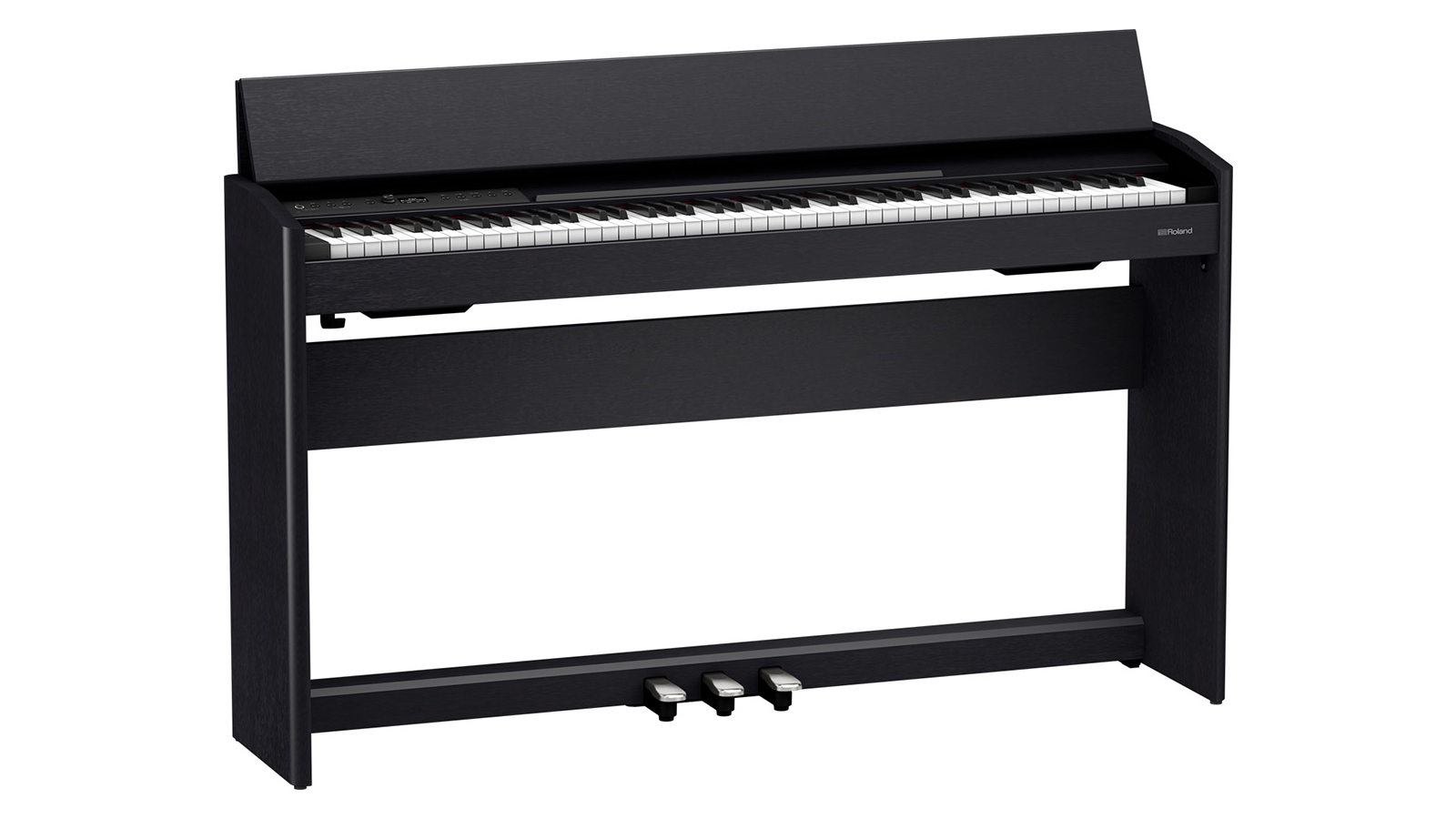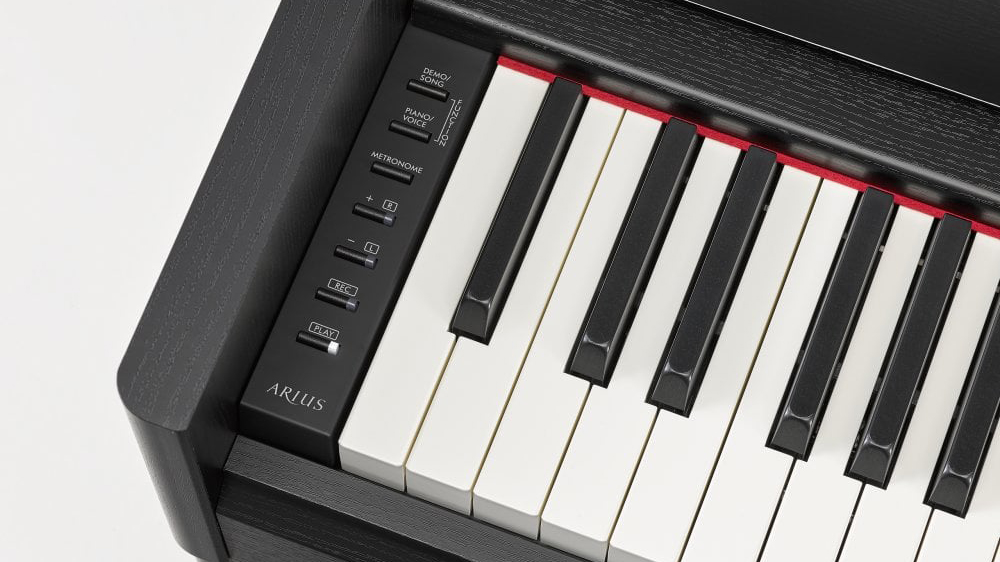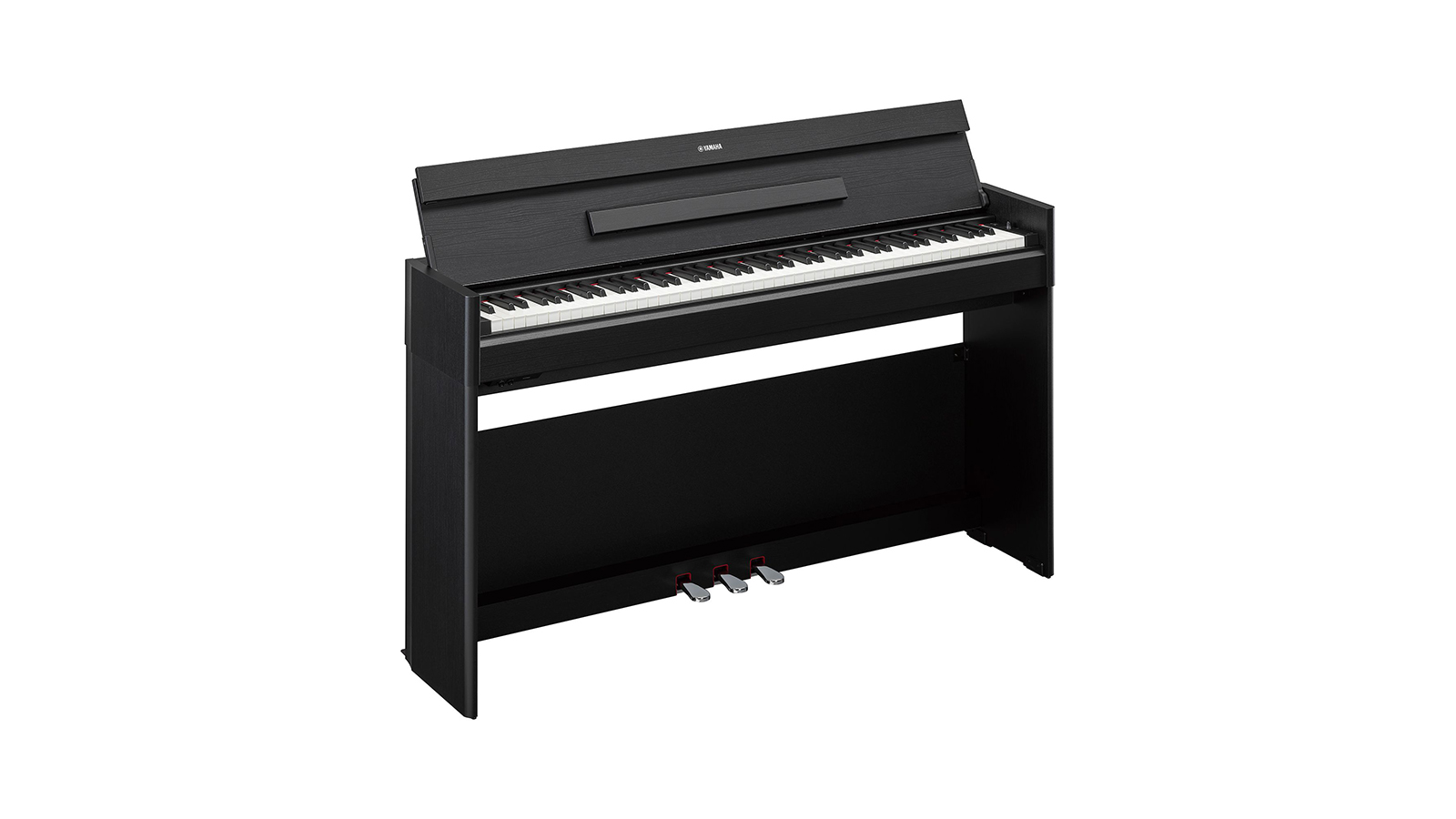MusicRadar Verdict
The S55 is a brilliant choice for space-strapped beginners or more advanced pianists who don't need loads of extra bells and whistles, although Smart Pianist compatibility does up the ante somewhat in terms of extra features and ease of use. Essentially, there are two main ingredients that make a great digital piano - an excellent keyboard and superb grand piano tone, and both of these are fully addressed here. Available in black or white with a 3-month Flowkey online lesson membership included, the extra responsiveness of the GH3 keyboard and the upgraded speaker system make the S55 a worthwhile choice over the S35 for those who don’t have the space for a full-size model.
Pros
- +
Incredibly compact
- +
Superb CFX piano sound
- +
Great keyboard for beginners
Cons
- -
Only 10 sounds
- -
No Bluetooth function
- -
No Wurlitzer piano voice
MusicRadar's got your back
Yamaha Arius YDP-S55 review: What is it?
Yamaha's Arius range of stylish, budget-friendly digital home console-style pianos received a refresh in early 2022, which saw the introduction of two new slimline versions of the existing, full-size models. As a result, the range now consists of four pianos, the YDP-165, YDP-145, YDP-S55 and YDP-S35, all designed to combine the elegant form and rich tone of a traditional acoustic piano with the compact footprint and practicality of a digital piano.
The YDP designation stands for Yamaha Digital Piano, and while the 145 and 165 are the two full-size models, the S denomination represents the Slimline models, shallower from front to back to allow them to fit into smaller living spaces. Of the two, the S35 is the more affordable, while the S55, the focus of this review, is the more premium model, meaning that the S55 is to all intents and purposes the same piano as the 165 but in a more compact cabinet.
Yamaha Arius YDP-S55 review: Performance & verdict

The main difference between the S55 and the S35 is that the S55 features an enhanced Yamaha CFX grand piano sound, a more powerful speaker system and Yamaha’s GH3 keyboard (with an extra third sensor), rather than the GHS (Graded Hammer Standard) keyboard found in the S35. The GH3 features 88 full-size, weighted plastic keys that are graded in weight from heavier on the left to lighter in the upper octaves, just like on an acoustic piano.
The keys in the GH3 are designed to bounce back faster than those in the GHS, responding more like high-quality piano keys, and that extra third sensor allows improved rapid note repetition and expressive control, making the S55 an extremely satisfying instrument to play. Where the S35's keys have a smooth matt finish, the keytops on the S55 are textured to reduce slippage when things get really frenetic!
Meanwhile, the half-damper pedal setting reproduces the pedal response behaviour of an acoustic grand, making the overall experience even more authentic..
Slim Pickings
With regard to cabinet design, the S55 has a modern, minimalist look that has a lot to do with the fact that it's so amazingly compact. Measuring a mere 309mm from front to back, the YDP-S series is one of the slimmest console-style home digital pianos on the market, perfect if you're a bit strapped for space. When not in use, the folding keyboard cover becomes a flat, tabletop-like surface when closed, giving the instrument something of the look of a hallway table.
To facilitate student/teacher interaction, there are twin 6.3mm headphone sockets located just far enough forwards on the underside of the keyboard to be accessible without needing to crawl underneath, and there’s also a Duo mode that splits the keyboard into two four-octave pianos, so teacher and student can play together side by side. Adjacent to the headphone jacks sits a USB port that's used to connect to a computer so you can use your piano as a MIDI controller.
Sound reasoning

Yamaha Arius YDP-165
Full-bodied version of the YDP-S55 with a larger cabinet.
Roland F701
Slim home piano from Roland with minimalist modern styling, SuperNATURAL piano engine and PHA-4 keybed.
With just 10 sounds on board, Yamaha have clearly gone for quality over quantity here - you get the same number of internal sounds as the rest of the YDP range. Largely because of this, the S55 is simple to operate, scoring highly in our ‘turn on and play’ test. The meticulously-sampled CFX grand piano tone is excellent, and the reduced depth of the cabinet doesn't have the detrimental effect on the sound that you might expect - we anticipate that some black magic trickery has taken place in the design of the 2 x 20W speaker array (as opposed to 2 x 8W on the S35) to facilitate this, as the main CFX grand piano sound is full and rich.
Yamaha’s entry-level virtual resonance modelling technology, VRM Lite, is present here too, giving you convincing sympathetic resonance between adjacent notes when the damper pedal is held down, mimicking the way the strings, soundboard and cabinet interact on an acoustic piano.
Aside from the CFX concert grand, the other voices are more than serviceable - the Rhodes and DX E-piano tones tick all the boxes, along with the harpsichord, vibraphone and organ tones. On the downside, we did encounter a curious lack of sustain on the strings voice, a foible common to the other models in the Arius range, and being Wurli fans, we really would have appreciated a Wurlitzer EP200A voice in there somewhere to fuel our Fleetwood Mac obsession - it’s only logical after all!
Bonus banquet

In terms of extra features, there's not an incredibly long list - there's no Bluetooth for example, so you can't stream audio through the piano's speakers to play along to. However, you do get Intelligent Acoustic Control, which corrects the sound balance optimally according to the volume you set, plus a Stereophonic Optimizer to make playing while using headphones a more immersive experience, both of which seem to do what they say on the tin.
The real bonus though, is that like the other Ariuses, the S55 is compatible with Yamaha’s free Smart Pianist app for mobile devices. This transforms a handy iPad or Android tablet into a large touchscreen display for your piano, making it much easier to access the internal settings. You can use the iPad to change voices, call up the scores of the built-in songs and use the Piano Room function to adjust the tonal quality and resonance settings of the piano tone in a much easier to use visual environment. It really does change the functionality of the instrument to a serious degree, making it easier to work with the 10 demo songs, 50 classical onboard songs and 303 lesson songs.
Yamaha Arius YDP-S55 review: Hands-on reviews
Alamo Music Center
Yamaha Global
Bonners Pianos & Keyboards
Yamaha Arius YDP-S55 review: Specification
- Keys: 88-note GH3 keyboard with synthetic ebony and ivory textured keytops
- Dimensions: (W x D x H, mm) 1353 x 309 x 792 (Closed), 1353 x 317 x 976 (Open)
- Weight (kg): 40
- Sounds: 10
- Polyphony: 192
- Pedals: Damper, Sostenuto, Soft (Half-pedalling supported)
- Speakers: 2 x 20W, 12cm
- Contact: Yamaha
Dave has been making music with computers since 1988 and his engineering, programming and keyboard-playing has featured on recordings by artists including George Michael, Kylie and Gary Barlow. A music technology writer since 2007, he’s Computer Music’s long-serving songwriting and music theory columnist, iCreate magazine’s resident Logic Pro expert and a regular contributor to MusicRadar and Attack Magazine. He also lectures on synthesis at Leeds Conservatoire of Music and is the author of Avid Pro Tools Basics.
“Excels at unique modulated timbres, atonal drones and microtonal sequences that reinvent themselves each time you dare to touch the synth”: Soma Laboratories Lyra-4 review
“I used everything I knew about music”: How Green Day exceeded expectations with their most ambitious song
YouTube just added AI tools that makes musicians, library music and video editors redundant











